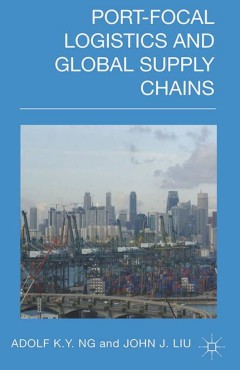Ditapis dengan

Container Liner Shipping, Port Development and Competition
This chapter reviews and analyses the contemporary development of liner shipping, port development and competition. It begins with a comprehensive review on the latest developmental trends of liner shipping and business strategies, as well as their impacts on port development and competition. Then, it discusses the responses of ports, past, present and (likely) future, in addressing these new d…
- Edisi
- Vol. 13 Iss 4 pp. 401-446
- ISBN/ISSN
- 978-1-78052-340-8
- Deskripsi Fisik
- 27P
- Judul Seri
- Maritime Logistics
- No. Panggil
- ATC LO YNG c

Climate Change and Adaptation Planning for Ports
seaports has broad implications for the development prospects of the global economy. However, the picture is very uncertain because t he impacts of climate change will be felt very differently around the world, both positively and negatively. This book addresses the need for quality theoretical analysis, highly innovative assessment methodologies and insightful empirical global experiences so a…
- Edisi
- 2016
- ISBN/ISSN
- 978-1-315-75681-3
- Deskripsi Fisik
- 319p
- Judul Seri
- Climate Change and Adaptation Planning for Ports
- No. Panggil
- TXT PO YNG c

Port-focal logistics and global supply chains
- Edisi
- -
- ISBN/ISSN
- 978-1-137-27369-7
- Deskripsi Fisik
- xx, 240 p.
- Judul Seri
- -
- No. Panggil
- TXT LO ADO p
- Edisi
- -
- ISBN/ISSN
- 978-1-137-27369-7
- Deskripsi Fisik
- xx, 240 p.
- Judul Seri
- -
- No. Panggil
- TXT LO ADO p

Container liner shipping, port development and competition
This chapter reviews and analyses the contemporary development of liner shipping, port development and competition. It begins with a comprehensive review on the latest developmental trends of liner shipping and business strategies, as well as their impacts on port development and competition. Then, it discusses the responses of ports, past, present and (likely) future, in addressing these new d…
- Edisi
- Vol. 13 Iss 4 pp. 401-446
- ISBN/ISSN
- 978-1-78052-340-8
- Deskripsi Fisik
- 27 p.
- Judul Seri
- Maritime Logistics
- No. Panggil
- ATC LO ADO c

Across the waves : a bibliometric analysis of container shipping research sin…
The paper investigates collaborative and semantic patterns that emerged between 1967 and 2013 about the theme of container shipping based on a corpus of 294 articles published in scholarly journals within the fields of transportation, supply chain, economics, geography, regional planning and development, and operations research. An analysis based on the cooccurrence of title words allows identi…
- Edisi
- -
- ISBN/ISSN
- 1464-5254
- Deskripsi Fisik
- 19 p.
- Judul Seri
- The flagship journal of international shipping and port research
- No. Panggil
- ATC LO LAU a

Port-Focal Logistics and Global Supply Chains
This book explores the intersection of two trends in the port sector that have occupied researchers in recent years: the port's progressively interventionist role in the hinterland and its increasing importance as a node within supply chains. These trends are set against the backdrop of fierce port competition as the increasing size of modern container vessels drives ports to make huge investm…
- Edisi
- -
- ISBN/ISSN
- 978-1-349-44539-4
- Deskripsi Fisik
- -
- Judul Seri
- -
- No. Panggil
- TXT PO ADO p
Port-Focal Logistics and Global Supply Chains
- Edisi
- -
- ISBN/ISSN
- 978–1–137–27368–0
- Deskripsi Fisik
- xx, 244 p
- Judul Seri
- -
- No. Panggil
- TXT PO ADO p
- Edisi
- -
- ISBN/ISSN
- 978–1–137–27368–0
- Deskripsi Fisik
- xx, 244 p
- Judul Seri
- -
- No. Panggil
- TXT PO ADO p

Evolution and research trends of container shipping
- Edisi
- vol. 40
- ISBN/ISSN
- 1464-5254
- Deskripsi Fisik
- 22 pages
- Judul Seri
- Maritime Policy & Management
- No. Panggil
- ATC PO LAU e
- Edisi
- vol. 40
- ISBN/ISSN
- 1464-5254
- Deskripsi Fisik
- 22 pages
- Judul Seri
- Maritime Policy & Management
- No. Panggil
- ATC PO LAU e
 Karya Umum
Karya Umum  Filsafat
Filsafat  Agama
Agama  Ilmu-ilmu Sosial
Ilmu-ilmu Sosial  Bahasa
Bahasa  Ilmu-ilmu Murni
Ilmu-ilmu Murni  Ilmu-ilmu Terapan
Ilmu-ilmu Terapan  Kesenian, Hiburan, dan Olahraga
Kesenian, Hiburan, dan Olahraga  Kesusastraan
Kesusastraan  Geografi dan Sejarah
Geografi dan Sejarah